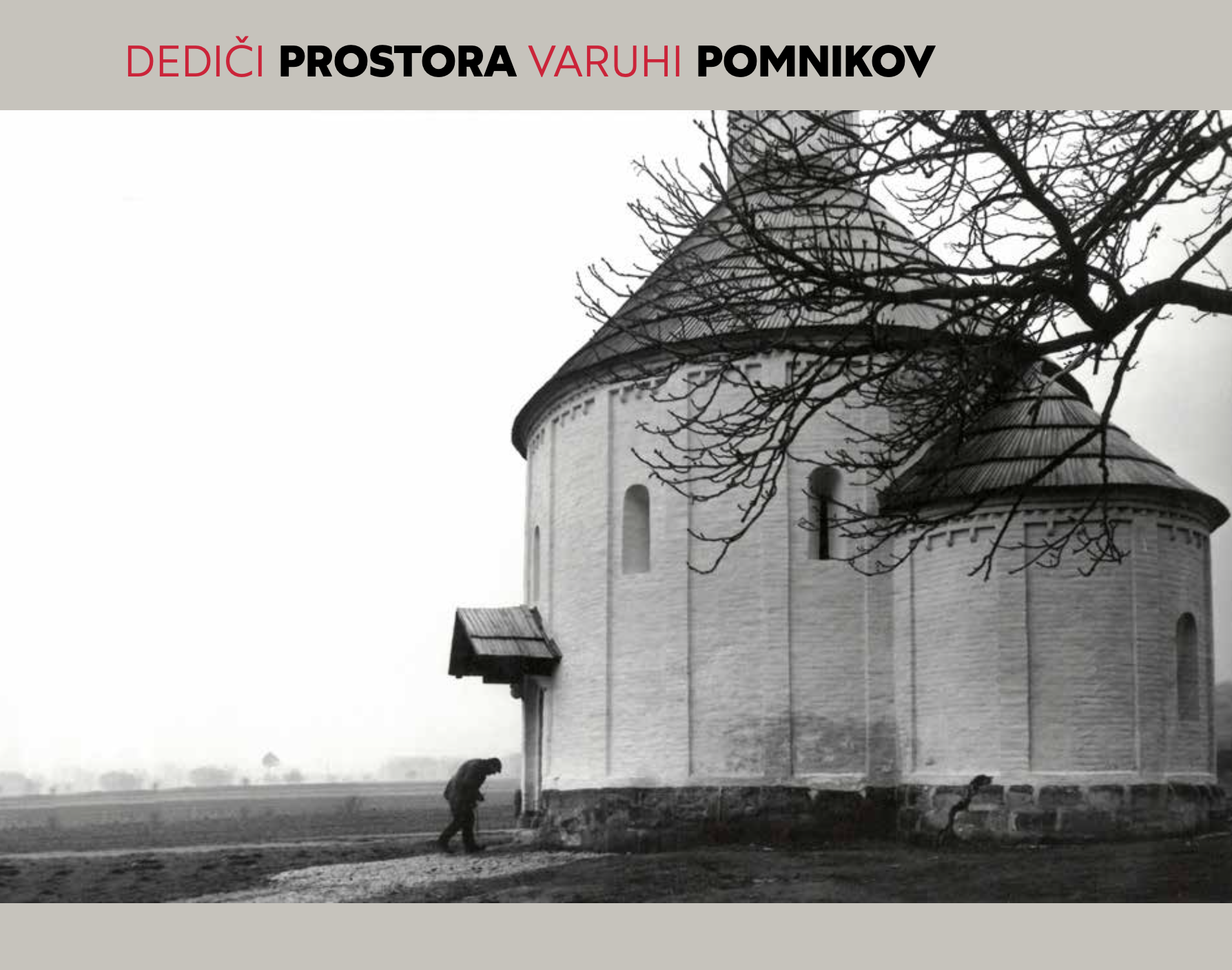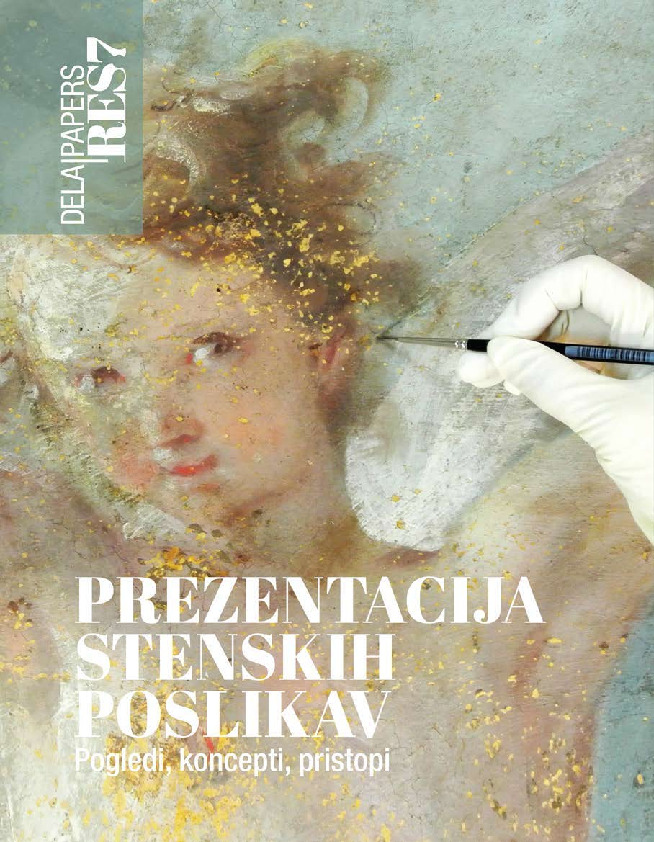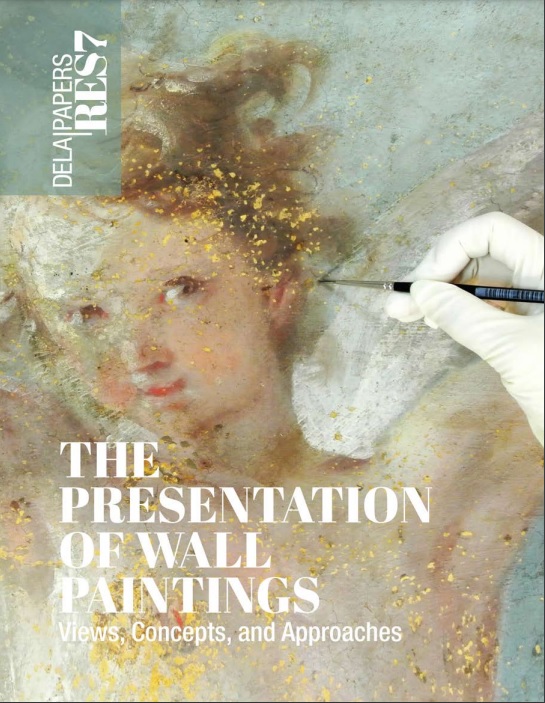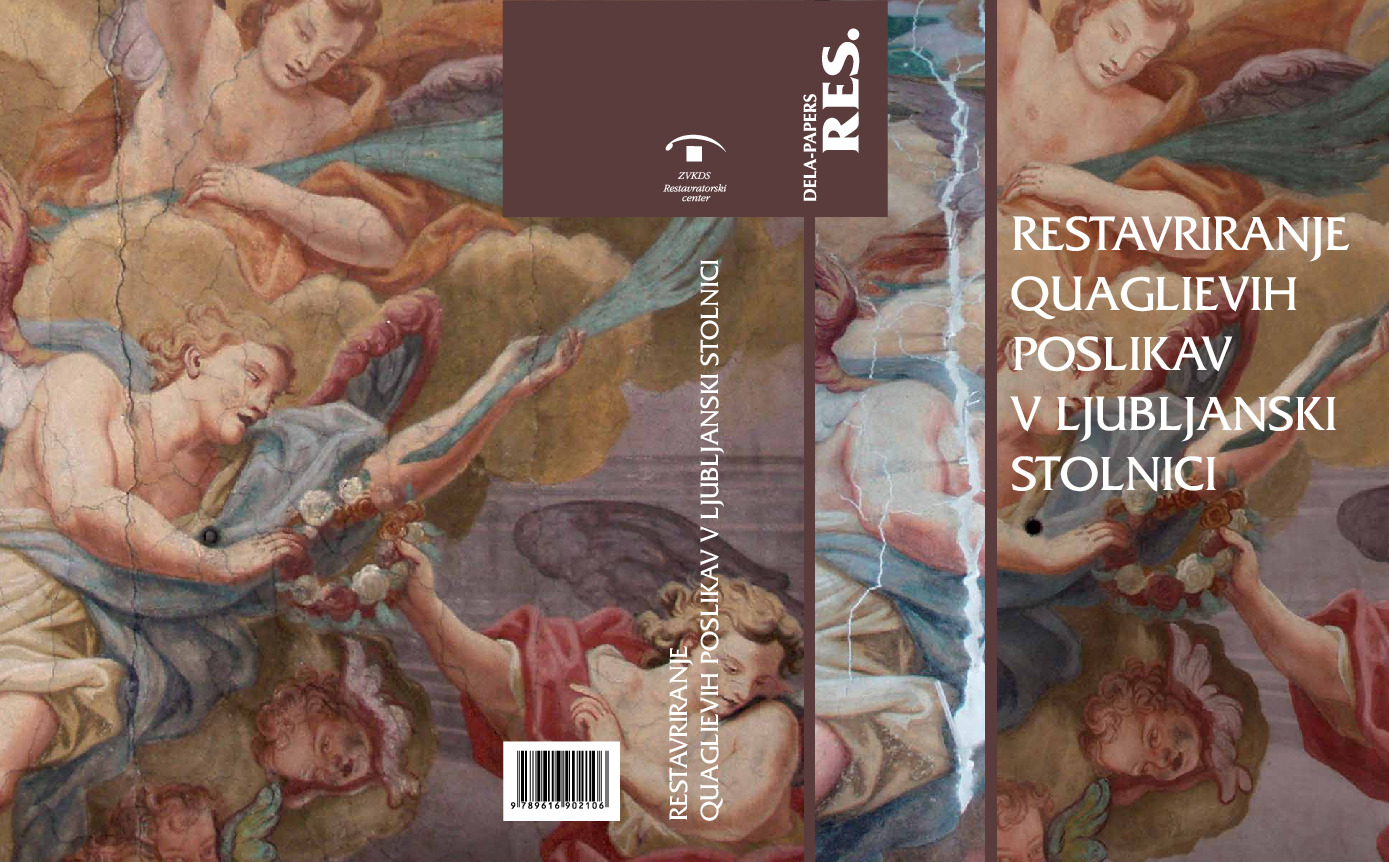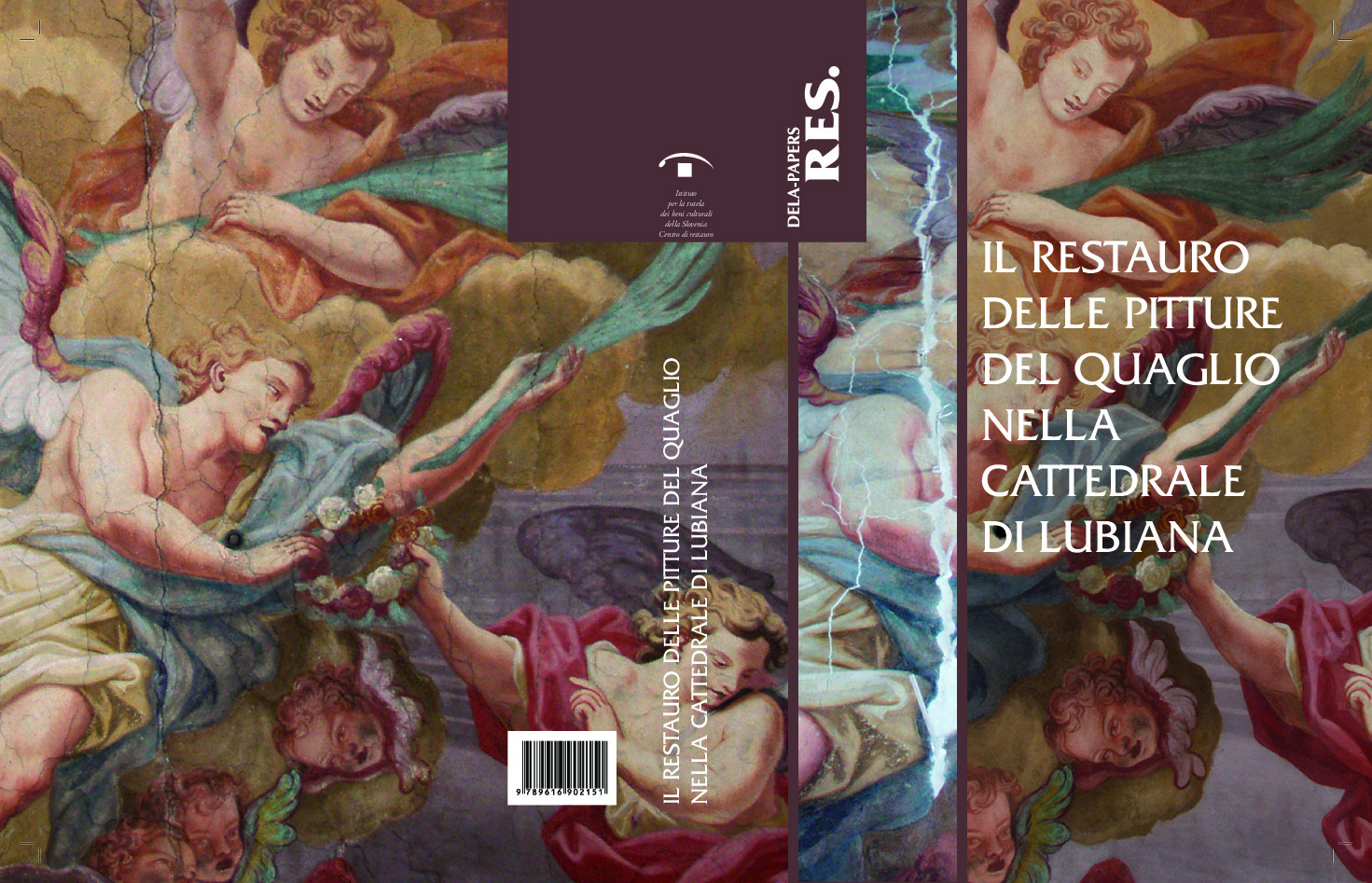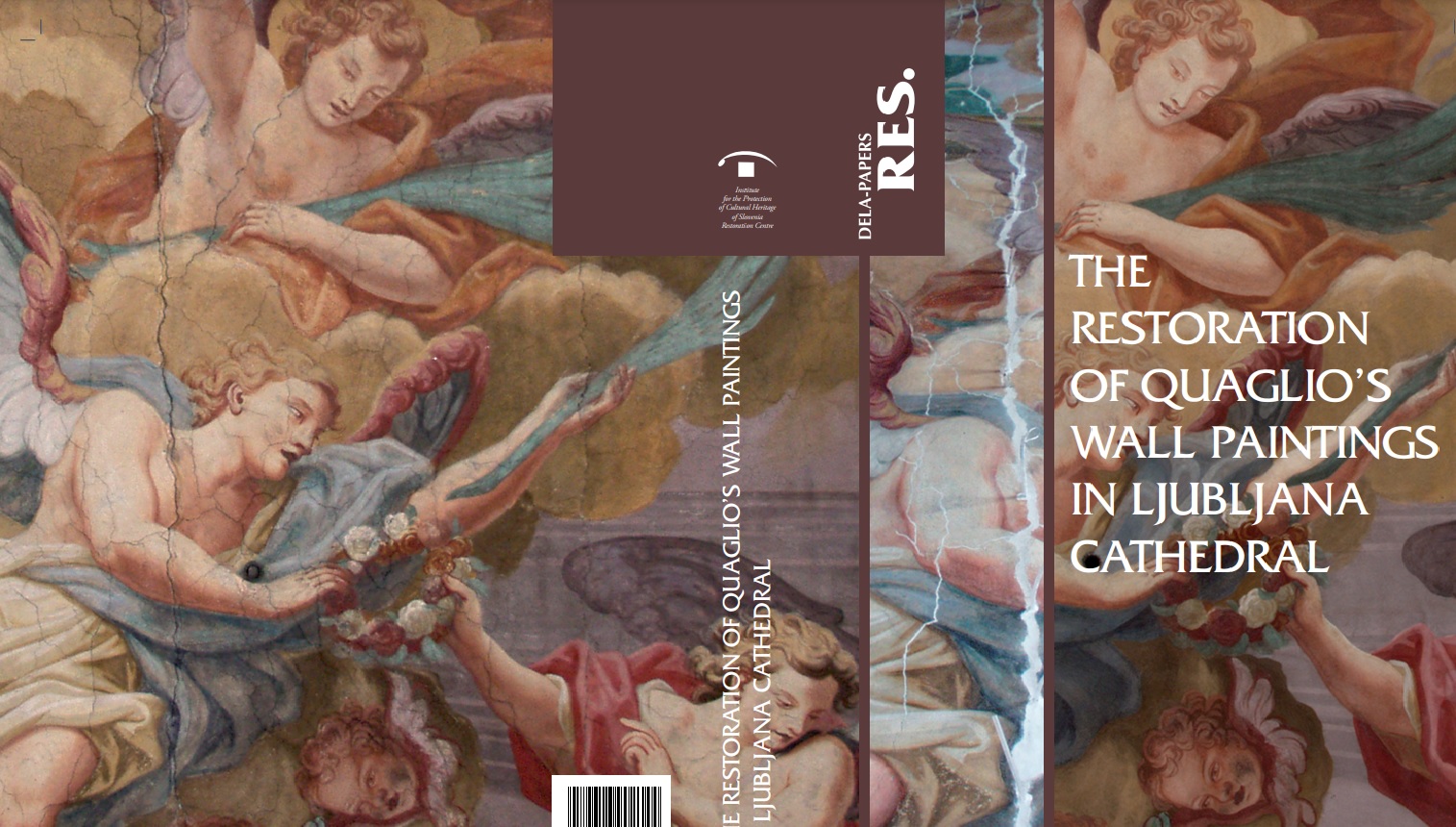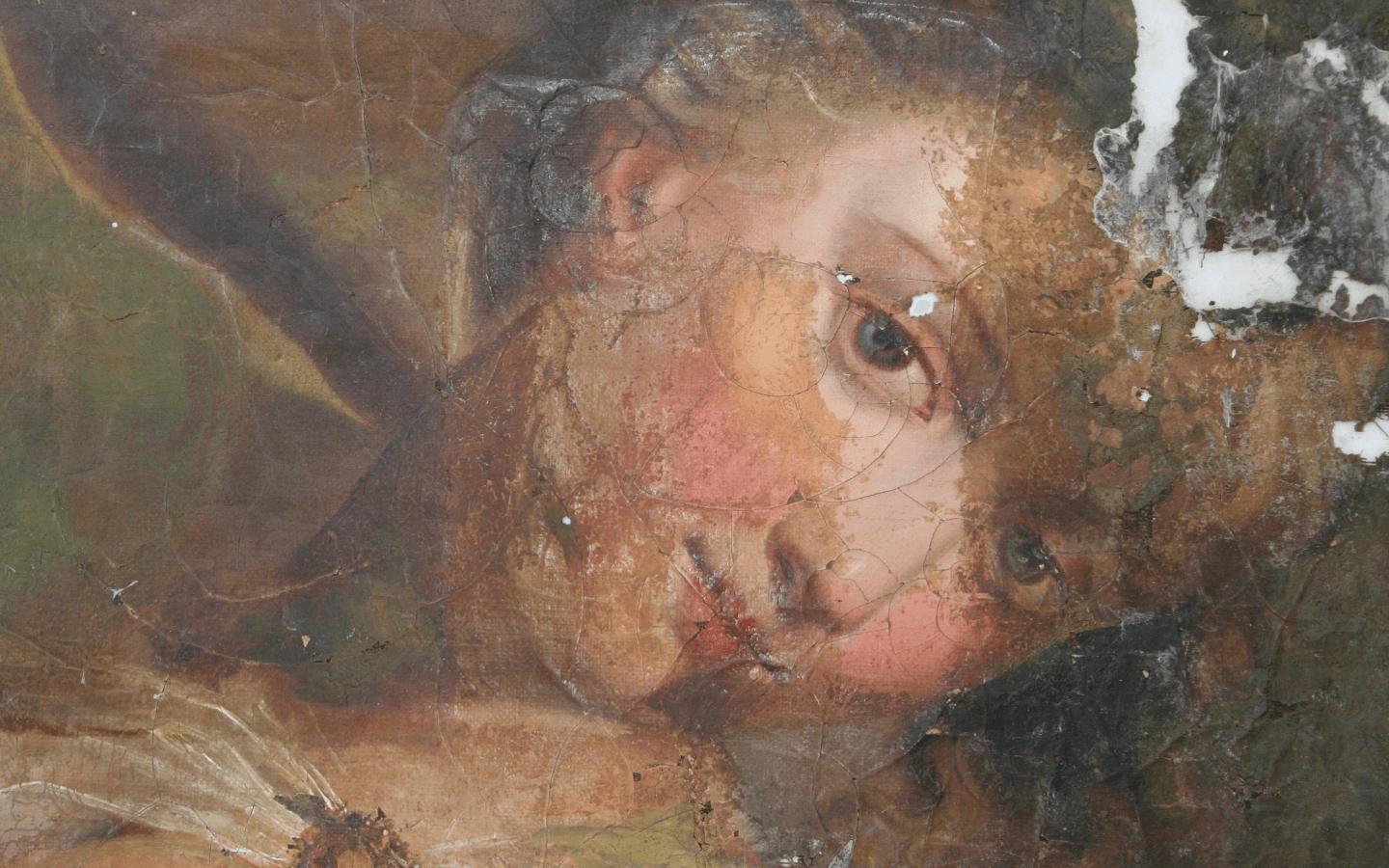
RES.
RES. is a periodical interdisciplinary scientific and professional publication of the IPCHS Restoration Centre. The distinctive acronym RES. denotes the topic it deals with - restoration, which depends on the findings of various disciplines. The issues are thematically oriented, monographically complete and translated into various foreign languages.
The earliest issue, a precursor to the RES. publication, was Razprave (Discussions), published in a single issue in 1990 under the title Hrastovlje: restoration interventions on wall paintings by Ivan Bogovčič.
The author of the conceptual design of RES.a in the form of Works - Papers was Josip Korošec in 1992 as Director of the Restoration Centre of the Republic of Slovenia. Between 1992 and 2000, 4 issues were published. Then, due to the overload of restorers with the main activity, the publication of the Restoration Centre came to a standstill.
Introducing
The RES. publication was relaunched in 2012 with the publication of the 5th issue in the form of a monograph. With a new concept, it is conceived as an interdisciplinary scientific and professional monograph with peer-reviewed contributions, equipped with scientific apparatus, a glossary of terminology and translated mostly into English and Italian. The topics are complex conservation and restoration projects, presented in depth in pictures and in writing, with all conservation and restoration procedures, interdisciplinary research such as art historical, conservation, restoration, natural science and technology, etc. and thus with the latest knowledge about the monument or artwork. The publication is also devoted to specific monument conservation issues that are not necessarily linked to completed restoration projects. We are aware of the important mission of the conservation service, which, in addition to the concrete solution of cultural heritage, also means the consistent documentation, research and publication of the research and interventions carried out. We translate practical conservation and restoration work and experience into words, which helps the profession to germinate and develop, and disseminate new knowledge about monuments to the professional and general public, while leaving the written word for posterity, who will one day face similar conservation problems again.
Editorial Board
Institute for the Protection of Cultural Heritage of Slovenia
RES. - Editorial Board
Poljanska cesta 40
1000 Ljubljana
Editor: Mateja Neža Sitar E: mateja.neza.sitar@rescen.si
The Editorial Board is determined separately for each issue of RES.
Reviewers are assigned separately for each issue of RES.
Instructions to authors
General instructions
- Authors are cordially invited to contribute to RES publications. Text and images should be sent electronically, addressed with the author's surname, to the Editor-in-Chief's e-mail address: mateja.neza.sitar@rescen.si
- Submission and publication of an article in RES. publications implies that all authors agree to the publication and content of the article. It is the responsibility of the first author to inform the other authors of the publication. The author takes full responsibility for his/her article. The article must not be in the process of being published in any other publication. The author may not infringe copying rights. Once an article is accepted, the copyright passes to the publisher.
- The article should be written in the Slovene literary language, in accordance with the rules of the Slovenian Standard Common English Language (SSKJ) and the Slovene orthography.
- Foreign authors write in English or, depending on the agreement, in their mother tongue.
- Contributions should be written in 1st person plural.
- For the size of the contribution, the following is recommended half of the copyright pole (8 pages or 15,000 characters, including spaces and footnotes) for publication in the form of proceedings or proceedings; and 1 author's pole (16 pages or 15,000 characters including spaces and footnotes) for publication as a monograph. The size depends on the thematic concept of each issue.
- The RES.-a editorial board decides on the acceptance of articles for publication, arranges for the peer review of the article, and arranges for translations and linguistic corrections in Slovenian and foreign languages.
- Once an article is accepted for publication, the peer-reviewed and proofread article is returned to the author. The author makes corrections and returns the article, adjusted to the guidelines for the preparation of the manuscript.
Preparation of the contribution
- unformatted text in a Microsoft WORD document in Times New Roman font, font size 12 (14 for headings), 1,5 spacing, on A4 format, with 2,5 cm margins, justified on both sides
- the authors' details on the first page (name, surname, education, professional title, position, institution, address, telephone number, e-mail address)
- title of the article (subtitle if applicable)
- keywords (up to 8 words)
- abstract (up to 100 words)
- Executive summary (up to 200 words)
- the text of the article in the following order: keywords, abstract, summary, introduction, main text - divided into chapters with the results presented in the discussion, conclusion
- footnotes (Times New Roman, 10 point font, single spacing, double-sided alignment); footnotes should include both substantive notes and references - sources and literature, with the obligatory citation of foreign peer-reviewed literature alongside the domestic literature; footnotes should include sources and literature for citations, market names and other information about the material, acknowledgements, additional comparisons, explanations, etc.
- a list of numbered pictorial material (photographs, graphs, tables, tables) with associated captions - a commentary and, of necessity, the source of the image at the end of the text (author, date, location: e.g. Fig. 1: Detail of an undergarment during restoration, photo. (Figure 1) or (Table 1)... etc., on the CD-ROM (jpg or tif format) the image material must be numbered in the same way as in the list and in the text.
- for pictorial material, the source and location must be consistently acknowledged, and copyright permission for publication must be obtained (from official institutions, from private individuals, from the Internet) in order to protect copyright; it must also be stated whether the material has been graphically manipulated
- mathematical and chemical formulae
- units of measurement and equations (SIST ISO 2955, SIST ISO 31 series and SIST ISO 1000)
- the names of companies and materials must be consistently given in the original. Where the original trade name of the material is registered - capitalised, italicised, e.g. Arbocel®, Calosil®, where it is not registered, usually lowercase
- alphabetical list of literature and sources
- alphabetical list of abbreviations with explanatory notes
- alphabetical list of materials (restoration, chemical, ....)
- an alphabetical annotated list of technical terminology
Authors' details: The corresponding author's name, surname, title, profession, institution, address, telephone number and e-mail address should be indicated.
Article title: The title of the article should be as short as possible, attractive, precise and informative, and should not exceed 80 characters.
Keywords: Keywords can contain from 4 to a maximum of 8 words, which are used by the author to define the content of the article and are suitable for indexing and search.
Excerpt: Include a brief summary of the content of your contribution (up to 100 words).
Summary: The abstract should be between 250 and 300 words (less if it is a shorter article), presenting the essential content of the article in a concise way and capturing the reader's attention. It should be written in the past tense. Reference to formulae, equations, references in the abstract is not allowed and abbreviations and acronyms should be avoided. The abstract will be translated into the foreign language immediately after the paper.
Text of the article: The text of the article should be written clearly and concisely. Even if it is your own research, the article should be written in the first person plural or third person. Articles should follow the scientific apparatus (abstract, summary, keywords, footnotes, use of comparative sources, reference list). The following thematic structure is recommended: Introduction, Experimental or practical part, Results with discussion, Conclusion, Acknowledgements, References. The full text of the paper should be written with the assumption that the aim is to attract both a professional and a general audience. Practical procedures and procedures or experimental techniques and apparatus should be described in detail if they deviate significantly from descriptions already published in the literature; for known techniques and apparatus, the source where the necessary explanations can be found should be given.
Article formatting: The text should be written in one of the more widely used word processors (Word or Word Perfect) on A4 paper, 1.5 spaces and 2.5 cm margins, with double-sided alignment of the text on numbered pages. The digital record should be completely straightforward, without complex formatting, word splitting, underlining, and the author should only indicate bold and italic underlining. The text should be in lower case and should be free of unnecessary abbreviations and acronyms (if used, a list explaining the abbreviations should be added at the end). All pictorial material, including tables, chemical formulae and associated descriptions, should appear in printed form at the end of the full text, but the location of the pictorial material/table or chemical formulae should be specified in the text.
Images: There is no strict limit to the number of images, depending on the topic and the issue; for RES. publications, visual material is particularly important. For an 8-page text, 10 to 15 photographs are suggested, even less. The final selection is determined by the Editorial Board.
- Each contributor chooses either colour, black and white or graphic photographs.
- All photographs must be accompanied by an explanation or 'caption', including information on whether the photograph has been edited or graphically enhanced, the author and date of the image (in the absence of this, 'author and date unknown'), the source (e.g. if the image is from a book, article, website, etc.) and the location (e.g. name of archive, library, etc.).
- The author must ensure that the quality of the photographs, and in particular reproductions from books, the internet, etc., is sufficient.
- For images for which the author does not hold the copyright, each author must obtain permission to publish from the copyright owner (e.g. institutions, private parties), and for photographs from the web, it is also necessary to check whether publication is permitted and to make a consistent statement to this effect in the description of the image.
- All images to be published should be added to the text as a separate file from the text of the article, in the form of JPEG (can also be in one of the following formats: TIFF (.tiff; .tif), JPEG (.jpg; .jpeg) or BMP (.bmp), as an Excel (.xls) document).
- Images should be of minimum resolution 300 dpior a size that is 1.5 to 3 times the size of the printed graph (photographs, graphic sketches, microfilm, scanned material, exceptionally good photocopies).
- Files should be named as they are in the text (e.g.: Figure 1.).
- Images should be labelled with a number and caption (explanation, to which you should add the author, source and time of creation, if not you, the location);
EXAMPLE: Figure 1: Cross-section of the colour layer, author and time of the image (each image must have a comment or caption (in which you explain, among other things, whether it is a photograph, a drawing, a graphic sketch, etc.); if there is repetition (author, time of creation and location of the image), you can only provide this information once, at the 1st mention in a separate note.
Spreadsheets, tables: Just as for figures, tables and tables should be added to the text of the article as a separate file (e.g. table name: tabela1.xls), unless the table is created with a text editor. Tables and tables, including charts, diagrams and graphs, should be constructed in such a way that they can be understood without reading the text of the article. Headings in tables/tables should be brief. When editing tables in a text editor, tabs should be used to separate columns, not spaces.
Mathematical and chemical equations: Each formula should have a sequential number written in round brackets on the right-hand side. In the text, e.g. Equation 1 should be referred to rather than '... as follows:, ... as shown below:', because for technical reasons it is not possible to place the formula in the exact places in the article. Any special characters (Greek letters, etc.) should be explained separately below the equation or in the text. The equations should be prepared in Word using Arial font.
Units and equations: The use of the units of measurement laid down in the Ordinance on Units of Measurement (Official Gazette of the RS No 26/01), i.e. the units of the International System of Units (SI), is mandatory. The use and the script must comply with SIST ISO 2955, SIST ISO 31 series and SIST ISO 1000 according to this Ordinance.
Notes: Authors write substantive comments, quotations, sources in FOOTNOTES footnote. Literal quotations should be enclosed in quotation marks and italicized both in the text and in footnotes.
PRIMER: "/.../ in the light of ongoing chemical analyses /.../"²; at the end of the in-text quotation, footnote the source or author of the quotation according to the following rules:
Citing archival sources: indicate the archive, the fonds or collection code, the name of the fonds or collection, the number of fascicles or boxes, if applicable, the s.p. - where there is no pagination
EXAMPLE: ARS, AS 1, Vicedom Office for Carniola, box. 1. or NŠAL, Ljubljana, Stolnica, f. 26, files - miscellaneous.
Citing literature (monographs): give the name and surname of the author, the title (and subtitle) of the work (in italics), place, year of publication, pages; s.p. - where there is no pagination
PRIMER independent publications: Emilijan Cevc, Slovenian art, Ljubljana 1960, pp. 11-15.
Citing literature (articles): the name and surname of the author: the title of the article, title of the periodical or proceedings (in italics)for a periodical, the year, year, issue and page; for a proceedings (name of the editor in brackets), the place and year of publication and pages.
PRIMER for periodicals: article:
Ana Lavrič, Planning and construction of the Ljubljana Cathedral, Protection of monuments, 37, 1997, pp. 32-45.
Meta Matijevič, The Novometi City Archive and its Care, Archives, 26, No. 1, 2003, pp. 221-226.
PRIMER for the proceedings: Matjaž Bizjak, Gutenberg and the Brixen estate east of Tržiška Bistrica, Ad fontes. Otorepč's collection (ed. Darja Mihelič), Ljubljana 2005, pp. 225-269.
Citing monographic electronic publications:
Il conferencia internacional textil/confecçao, 21-23 July 1999, Rio de Janeiro = 2nd International Textile and Apparel Conference, 21-23 July 1999, Rio de Janeiro [CD-ROM]. Rio de Janeiro: SENAI/CETIQT, 1999.
Citing articles from online electronic journals: italics only the name of the journal;
Helen ATKINS, The ISI Web of Science - links and electronic journals: how links work today in the Web of Science, and the challenges posed by electronic journals. D-Lib Magazine [online], vol. 5, no. 9, 1999. Online resource, accessed 3 February 2000: http://www.dlib.org/dlib/september99/atkins/09atkins.html
Citing websites, portals: italics only the name of the page or portal;
ASREACT - Chemical reactions database [online]. Chemical Abstracts Service, 2000, renewed 2 February 2000. Online resource, accessed 3 February 2000: http://www.cas.org/CASFILES/casreact.html
Quoting content from the web - avoid quoting information from unreliable and unverified sources, avoid Wikipedia. If we do use Wiki-sources, they should be supported by appropriate literature.
PRIMER: "Rheology is an interdisciplinary science concerned with the study of the behaviour of matter in all aggregate states, including gaseous, liquid, solid and plasma.": online resource, accessed 29 October 2014: http://en.wiki.fs.uni-lj.si/index.php/In%C5%BEenirska_reologija
Citing reports, research
Unpublished reports, research, studies should also be included, cited as usual, except that the title should not be italicized because it is not a publication; it is essential to add the reference at the end.
EXAMPLE:
Juša Vavken, Conservation Report on the Renovation of the Franciscan Parish Church of the Annunciation in Ljubljana, Renovation of the Façade of the Franciscan Parish Church of the Annunciation in Ljubljana 1992-1993, Ljubljana 1993, s.p., archives of ZVKDS OE Ljubljana.
Tomaž Kvas, Report on the restoration of the frescoes on the facade of the Franciscan Church in Ljubljana, 11 November 1992, archive of ZVKDS OE Ljubljana.
Quoting an oral source
As heritage conservation is an interdisciplinary teamwork, we also cite verbal warnings as an oral source, as well as experiences, observations, hypotheses, insights from workshops, meetings, lectures, which we support with comparative and more reliable sources.
EXAMPLE: On the advice/warning of restorer Franco Kokalj..., country, date.
Primary, secondary citation
We always strive for primary source information. If we find a reference to another source in a monograph that we want to use, we cite the original source. We can refer to the monograph in question as the source where we traced the finding.
The original source - i.e. the one that first pointed it out - takes precedence, but if a secondary source has added something significant, we cite that one too. In any case, we also cite the author who has worked extensively on the issue. Either we list the authors who have dealt with it alphabetically or, by citing a specific, e.g. the most recent, source, we point to the page where the older bibliography is listed.
EXAMPLE: This source was pointed out by LAVRIČ 2003, p. 420, citing sources and literature.
We can cite the most recent author who has pointed to this key source, e.g. when it comes to well-known findings. Some other possibilities. If we choose to cite all the sources that have dealt with the issue, we list them in chronological order.
EXAMPLE: GRUDEN 1908, p. x, STESKA 1934, p. x, LAVRIČ 2008, p. x.
Citing repeated sources - short form of citation
When a source is repeated a second or more time, it should be written in abbreviated form: the NAME in capital letters with the year, a comma, the pages cited. The source and the abbreviation should be written out in full following the citation instructions in the reference list. Also applies to online sources, unpublished sources (reports, studies, etc.).
EXAMPLES:
HUDOKLIN 1955, p. 136.
TILLINGHAST SHERMAN 2007, s.p. (online source).
Where the surname and year are the same for different sources, the sources are separated by alphabetical marking:
EXAMPLE: KOLLER 1996a, p. x; KOLLER 1996b, p. x.
If there are no known or multiple authors, write the beginning of the title or an identifier, which must be strictly adhered to in all subsequent references, followed by a comma, exceptionally, the year of publication, a comma, the pages cited.
EXAMPLES:
Report, 2007, p. x.
Slovenian art and its European context , 2007, p. x.
Bogoljub, 1907, p. 144.
A LIST OF SOURCES AND REFERENCES: All references and sources referred to in the text and footnotes should be included in the list at the end of the article. It should be listed in alphabetical order. Start with the abbreviation, then write out the source in full: capitalise the NAME, pages only if it is a periodical, collection, journal, with a full stop at the end.
EXAMPLES:
CEVC 1960: Emilijan CEVC, Slovenian art, Ljubljana 1960.
KOLLER 1996 a: Manfred KOLLER, Zur Vorgeschichte von Salzbelastungen am Denkmal: Salzschaden an Wandmalereien, Arbeitshefte des Bayerischen Landesamtes fur Denkmalpflege, 78, 1996, pp. 11-14.
KOLLER 1996 b: Manfred KOLLER, Das Denkmal ≫im neuen Glanze≪ - zur Reinigung und ihren Folgen, Denkmalpflege today. Proceedings of the Berner Denkmalpflegekongress October 1993 (ed. Volker Hoffmann, Hans Peter Autenrieth), Bern - Berlin - Frankfurt 1996, pp. 241-255.
LIST OF CONSERVATION AND RESTORATION MATERIALS
As most of the texts are about a conservation and restoration project, we list the conservation and restoration materials, tools and instruments used in a separate list. We list the Slovenian book name, the original name, the manufacturer and the source where we can find out more about it - e.g. a web link
EXAMPLE: Acetone (Acetone, ≥ 99.5 %) SIGMA - ALDRICH® Available on the World Wide Web: http://www.sigmaaldrich.com/catalog/product/sial/32201?lang=en®ion=SI
AN ANNOTATED LIST OF TERMINOLOGICAL TERMS
For the purpose of compiling the glossary of each issue of RES, each author prepares a list of terminology in his/her field of expertise. Please give a short and clear explanation of the terminology (taking into account the established terminology in the current professional-scientific literature and according to the guidelines of international regulations, charters, conventions; e.g. for conservation-restoration according to ICOM-CC, ECCO, AIC, ICOMCC, etc.) and in accordance with the rules of the SSKJ and the Slovene orthography (Slovene orthography).
EXAMPLES:
intonaco (it.) (or intonachino; it.) - professional → putty
putty - the last, top layer of fine, lime-rich plaster on which a fresco is painted; intonaco
wooden wedge sub-frame - a frame that can be extended by wedges in the corner grooves
Distribution: IPCHS Restoration Centre
